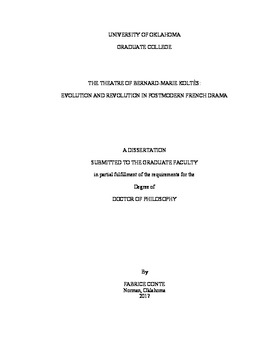| dc.description.abstract | The Theatre of Bernard-Marie Koltès: Evolution and Revolution in Postmodern French Drama establishes an understanding of French playwright Bernard-Marie Koltès (1948-1989) as the most important figure in postmodern French drama. This dissertation also reflects the interdisciplinary dynamic of theatre, always taking into consideration both its literary and its performative aspects.
In the Introduction, I describe the noticeable divide between Koltès’ importance in the realm of late twentieth-century French theatre and the problematic way in which the playwright is portrayed—that is, clearly underrepresented—in the most recent edition of Oscar Brockett and Franklin J. Hildy’s widely used textbook, History of the Theatre (First published in 1968. 10th edition published in 2008).
In Chapter One, “Bernard-Marie Koltès, Heir to the Project of Décentralisation Théâtrale,” I explore the complex socio-cultural and political context that fostered the emergence of Koltès as one of the most celebrated French playwrights of the twentieth century. I then trace the development of public theatre in France through the contributions of five prominent figures, all of whom are known as distinguished authors and stage directors: Maurice Pottecher, Romain Rolland, Firmin Gémier, Jacques Copeau, and Charles Dullin. I also discuss cultural policies implemented in France after World War II, policies that facilitated the organization of a remarkable network of public theatres across the country, as well as the career of influential actor-director Hubert Gignoux, who became Koltès’ friend and mentor. Finally, I devote the end of this chapter to the gradual public acclaim of Koltès, through a largely biographical narrative that emphasizes the connections between the playwright’s professional and personal achievements and the complex structure of public theatres that characterize the French theatre scene since the 1950s.
Chapter Two, entitled, “The Language of the Deal: Multilingualism and Identity in Koltesian Theatre,” is rooted in Koltès’ belief that all dramatic action is always transactional because characters can only interact within the context of a form of negotiation. Using this approach as a primary framework, I explore two crucial and interconnected characteristics of Koltès’ plays: their linguistic and racial diversity. In fact, some of the most interesting Koltesian transactions—which have become known as his “deals”—encompass the results of the encounter between characters who speak different languages and belong to different races. I begin the chapter with a discussion regarding the nature of Koltesian language, of which multilingualism represents one of the most distinctive features. Next, I provide an overview of multilingual theatre—an increasing trend in contemporary dramatic literature—and I offer an analysis of the role of multilingualism and race in Combat de nègre et de chiens. In the final part of Chapter Two, I discuss the challenges that emerge from the growing presence of multilingual drama, with special emphasis on questions related to the translation and production of multilingual plays, a topic quite relevant to the introduction of Koltès’ theatre in the United States.
In Chapter Three, “Myths and Mythification in Roberto Zucco,” I investigate the multidimensional relationship between myth, literature, and drama (with theatre simultaneously understood as a literary and performative art form) and I consider the concept of literary myth as a foundational element in theatrical practice. Following this discussion, I present a four-part myth-analysis of Koltès’ final play, Roberto Zucco, dating from 1989. The first part examines the mythification of the news event that inspired the play. The second, third, and fourth parts of this argument explore the emergence of three particularly prominent literary myths through the figure of Zucco: Hamlet, Samson, and Icarus. The deliberate incorporation of these mythical figures affirms Koltès as a playwright who belongs to the same twentieth-century tradition of French dramatic literature as Jean Cocteau, André Gide, Jean Giraudoux, and Jean Anouilh, among others.
In the Conclusion, I reflect upon the current state of teaching and production of Koltès’ plays in the United States, an undertaking that leads me to further argue in favor of a more substantial representation of Koltès’ contributions in the teaching of recent Theatre History. Finally, I offer some personal remarks, both formal and thematic, regarding my own experience directing Quai ouest in 2005 and translating and directing Roberto Zucco in 2014 for the University of Oklahoma Helmerich School of Drama. | en_US |
